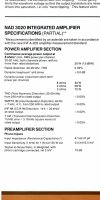Very interesting! A good luck.

I'm thinking of line source speakers myself. ,Line Array. Exciting concept.
Here are some tips and advice I picked up from those who are DIY line speakers, Line Array
Important that they really go from floor to ceiling to reduce floor, ceiling bounce.
Buy at least one extra speaker unit. It is not a question if when you will drive, for example, a screwdriver in an element, its when. Or that one of the elements you have orders is broken / measure wrong, have too much error.
Summation of ohm elements takes place via the number series. The geometric series is 1, 4, 9, 16, 25 and so on in order to be able to connect series / parallel to the same impedance as an element.
Measure the Ohm of each individual element and then macha so that it is even between the pair of speakers.
Design of line speakers, Line Array:
The challenge is, among other things, that for higher frequencies, the sound is more directly directed. As a consequence, using traditional programs for calculating speakers can be problematic. Check out this video. Something to think about in terms of how the sound is spread at different frequencies and thus get the right sensitivity, for the desired frequency curve over the entire register.
"But ... What about Line Source AND Line Array Loudspeakers?"
From another forum regarding calculating sensitivity:
"The series connection does not affect the sensitivity but increases the impedance. The parallel connection then gives 4 times higher amplitude because the same input voltage excites 4 groups of elements. The increase in sensitivity then becomes 20 * log10 (4) = 12 dB. With a starting point of 85 dB at 2.83 V, we thus reach 97 dB at 2.83 V.
We can reason a little about what that means. If a single element plays with 30W (at 8 Ohm) in, we have 85 + 10 * log10 (30) = 100 dB sound pressure. To reproduce this with 97 dB sensitivity, we only need 2W in 8 Ohm. If we divide this power into 16 elements, each speech coil sees an electrical power of 0.125 W.: D
"
Page 17 in this thread, I take up some examples of line speakers, arrays and speakers designed to reduce bounce . I added some pictures of different speakers. The question of what a "genuine" Line Source is, that is addressed.
There's a debate whether that's true or not Some say a big speaker in a small room is better than a small speaker in a small room And that there's no such thing as a "too big" speaker for a room. Honestly I don't know what is correct Well, say a couple of line speakers that go from floor to...

audiosciencereview.com
Edit:
Best to add. I'm not a professional but a happy amateur.

So best, if there is something you are wondering about in my post to get that verified if it is true from more knowledgeable and experienced people.



